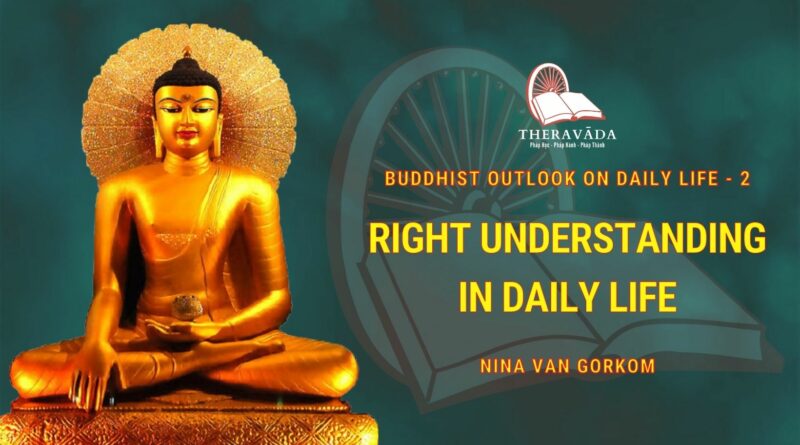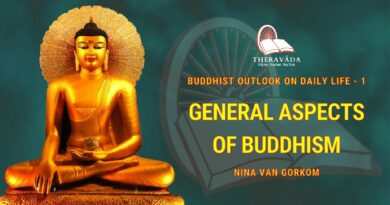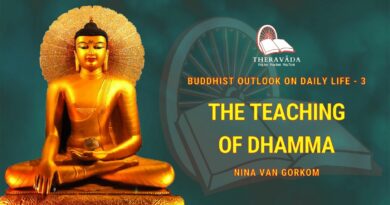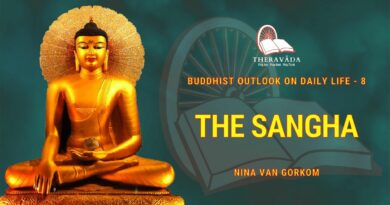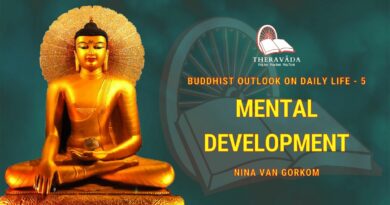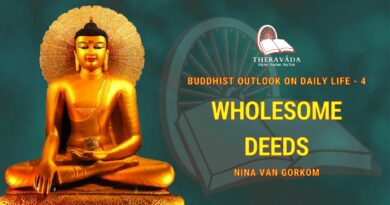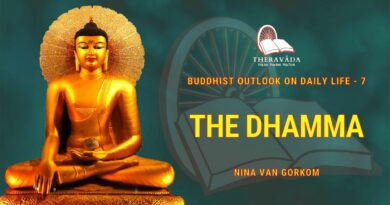BUDDHIST OUTLOOK ON DAILY LIFE – 2. RIGHT UNDERSTANDING IN DAILY LIFE
What is the effect of the Buddha’s teachings on people’s actions? In what way could the Buddha’s teachings effectively help people to perform wholesome deeds? Is it possible to do good deeds because a person with authority tells us: ‘Be detached and do good deeds’?
From experience we know that a good example might help to some extent, but the source of the good deeds is within ourselves: our mentality determines our actions. If someone wants to do his utmost to help other people he should understand himself first. He should understand the causes which make him act in this or in that way. If he develops the right understanding of these causes he will be able to lead a more wholesome life and to help other people in the most effective way.
Mentality is the source from which deeds spring: it is therefore not possible to determine the degree of wholesomeness from the outward appearance of deeds alone. There are many gradations of wholesomeness depending on the mentality which motivates the good deed.
Some people give money to needy people, but that does not mean that there may not still be conceit or other selfish motives. Others give without conceit, but they may have attachment: they give only to people they like. There are people who give out of pure lovingkindness, without any thought of attachment. This is a more wholesome way of giving.
We may wonder whether the study of so many details is necessary. In daily life we will see that it is very helpful to know the different kinds of citta and to know which citta motivates which kinds of citta and to know which citta motivates which kind of action. When we are able to know the different kinds of citta which succeed one another very rapidly, we will see that even while we are performing a wholesome deed, unwholesome cittas can succeed the wholesome cittas very closely.
“Wholesome’ is the translation of the Pali term ‘kusala‘. A wholesome deed in its widest sense means a deed which brings no harm to oneself or to other people at the moment the deed is done or later on.
In the ‘Discourse on the Foreign Cloth’ (Middle Length Sayings II, No. 88) we read about wholesome deeds, wholesome speech and wholesome thoughts, ‘skilled’ bodily conduct:
‘But what, revered sir, is skilled bodily conduct?’
‘Whatever the bodily conducts, sire, that has no blemish’
‘But what, revered sir, is the bodily conduct that has no blemish?’
‘Whatever the bodily conduct, sire, that is non-injurious.’
‘And what, revered sir, is the bodily conduct that is non-injurious?’
‘Whatever the bodily conduct, sire, that is joyous in result.’
‘And what, revered sir, is the bodily conduct that is joyous in result?’
‘Whatever bodily conduct, sire, does not conduce to the torment of self and does not conduce to the torment of others and does not conduce to the torment of both, and by which the unskilled states dwindle away, the skilled states increase much….’
The same is said about wholesome speech and wholesome thoughts. These words render the meaning of wholesome or ‘kusala’ in its widest sense. However, there are many intensities of kusala. There are higher degrees of wholesomeness than just abstaining from ill deeds which will harm oneself and others. IN developing ‘Right Understanding’ or wisdom, there can be kusala of a higher degree.
‘Wisdom’; is a translation of the Pali term ‘panna.’ Panna does not only mean knowledge acquired from the study of books, panna is insight into the realities of daily life as well. Panna can be developed in daily life. The degree of wholesomeness depends on the degree of panna which accompanies the wholesome citta. There are many degrees of panna, and each degree brings its result accordingly.
It is a typical Buddhist approach to life to study and to be aware of the different mental and physical phenomena which one can experience through eyes, ears, nose, tongue, body-sense and mind. If one is not used to this approach one might feel somewhat bewildered at first. However, after one has studied more these mental and physical phenomena, one will find out that only thus is it possible to understand the different ways in which oneself and other people behave, and to know which causes bring which effects in life. It makes no sense to speak in vague, general terms about realities, because the real understanding of our experiences in life can never be developed in that way.
Someone told me about a monk who was preaching in a way which was of great help to people in their daily lives. When I asked what the monk was preaching, the answer was that he was speaking about ‘citcai.’ ‘Citcai‘ is the word in Thai for ‘state of mind,’ in Pali ‘citta.’ This monk had the right approach to life. One should follow the example of the Buddha; one should not only tell people to do good deeds, but one should teach them as well how to do good deeds. In order to know how to do good deeds one should go back to the source of the good deeds; the mental states or ‘cittas.’ It is preferable to use the Pali term ‘citta’ rather than a translation from the Pali since translations do not render the meaning of the terms adequately. For example, the English translation of ‘citta‘ as ‘state of mind’ or ‘mental state,’ implies something which stays, which does not change. But that is not a characteristic of citta. When one has leaned more about ‘cittas‘ one will find out that there is no citta which stays even for a second. Each citta which arises falls away immediately, to be succeeded by the next citta. Cittas determine one’s own life and the life of other people; they condition the actions one performs in life.
Many people are not used to this approach; they are not used to looking at the outward appearance of things. Scientists are very advanced in the study of out space, but little is know about what goes on inwardly in man. People are used to paying attention to the things they see and hear, but they are not used to attending to seeing-consciousness and to hearing-consciousness. They do not think of the cittas which perform the functions of seeing and hearing.
Seeing-consciousness and hearing-consciousness are realities as well and it is therefore important to know more about them. That part of the Buddhist scriptures which analyses and explains mental phenomena and physical phenomena in detail is called the Abhidhamma. The Abhidhamma deals with everything which is real. Studying the Abhidhamma can change one’s life.
Many Thais listen to lectures about Abhidhamma, and not only those who have been educated at a college or university, but also those who have never received a higher education. I have heard of cases in which the study of different cittas has helped people to lead a more wholesome life. I heard of someone who was a first inclined to have feelings of revenge towards other people, and who was gradually able to overcome those feelings by understanding what those feelings were. Many Thais know about the realities taught in the Abhidhamma, and they know how to apply their knowledge in daily life. Foreigners do not usually hear about this because people do not often speak about Abhidhamma to foreigners.
Unwholesome mental states or ‘Akusala cittas’ and wholesome mental states or ‘kusala cittas‘ are realities of daily life. In order to know more about these realities one should try to understand oneself first: if one does not understand oneself one cannot help other people. This does not mean however that we have to wait our whole life before we can start helping other people. Even those who are just beginning to understand things as they are can help other people to have right understanding too.
Panna is the opposite of ignorance, which is the root of all defilement and sorrow. Panna is important for the development of kusala cittas. It is possible to do good deeds without panna, but if one wants to make progress in wholesomeness, panna should be developed. In understanding what is unwholesome and what is wholesome, and in understanding what is the result of unwholesome and of wholesome deeds, people are able to lead a more wholesome life.
There are many degrees of panna. When a teacher explains to his pupils that wholesome cittas with gratitude or honesty will bring a wholesome result and that unwholesome deeds motivated by greed or anger will bring and unwholesome result. The explanation may be the condition for them to have some degrees of panna. With panna they may be able to cultivate kusala cittas and to perform more wholesome deeds.
There is a higher degree of panna when people realize the impermanence of all the things they enjoy in life. When people see how short human life is, they will try not to be attached too much to the pleasant things of life. This understanding will stimulate them to a greater generosity and to move readiness to help other people. They will be less selfish.
Some people who have this degree of panna might change their way of life and live contentedly without any luxury. Others might decide ‘to go forth form home into homelessness;’ they might decide to become monks. A monk’s life is not an easy life. He lives without family and is ‘one who is contented with little.’ In the ‘Discourse of the Sixfold Cleansing’ (Middle Length Sayings III, No. 112) we read about a monk who tells of his renunciation of the world: ‘… I, your reverences, after a time, getting rid of my wealth, whether small or great, getting rid of my circle of relations, whether small or great, having cut off my hair and beard, having put on saffron robes, went forth from home into homelessness.’
The Buddha explained that people are too much attached to the sense-impression, received through eyes, ears, nose, tongue and body. He speaks about the ‘five strands of sense-pleasures.’ We read in the ‘Discourse With Subha’ (Middle Length Saying II, No. 99) where the Buddha speaks with Subha about the five strands of sense-pleasures:
… These five, brahman youth, are the strands of pleasures of the senses: What five? Material shapes cognizable by the eye, agreeable, pleasant, liked, enticing, connected with sensual pleasures, alluring. Sounds cognizable by the ear….. Smells cognizable by the nose …… Tastes cognizable by the tongue ….. Touches cognizable by the body, agreeable, pleasant, liked, enticing connected with sensual pleasures, alluring. These, brahman youth, are the five strands of sense-pleasures. Brahman youth, the brahman Pokkharasati or the Upamanna (clan) of the Subhaga forest glade, is enslaved and infatuated by these five strands of sense-pleasures, he is addicted to them, and enjoys them without seeing the peril (in them), without knowing the escape (from them)….
Everyone would like to have pleasant sense-impressions and everyone is inclined to attach too much importance to them. One is so absorbed in what one sees and hears that one forgets that sense-impressions are not true happiness. In the ‘Discourse to Magandiya’ (Middle Length Saying II, No. 75) the Buddha says to Magandiya:
Now I, Magandiya, when I was formerly a householder, endowed and provided with the five strands of sense-pleasures, revelled in them ….. But after a time, having known the coming to be and passing away of sense-pleasures and the satisfaction and the peril of them and the escape as it really is, getting rid of the craving for sense-pleasures, suppressing the fever for sense-pleasures, I dwelt devoid of thirst, my mind inwardly calmed. I saw other beings not yet devoid of attachment to sense-pleasures who were pursing sense-pleasures (although) they were being consumed by craving for sense-pleasures. I did not envy them: I had no delight therein…
People who understand that there is a higher happiness then the pleasures which one can enjoy through the five senses might apply themselves to the development of calm or ‘samatha.’ The calm which is developed in samatha is temporary freedom from unwholesomeness, form attachment, anger and ignorance. There are several meditation subjects of samatha, such as recollection of the Buddha’s virtue, mindfulness of breathing or lovingkindness. It depends on a person’s accumulations which subject conditions calm for him. Samatha is not a matter of just trying to concentrate on an object. Most important is right understanding of the meditation subject and of the way to attain the calm which is wholesome by means of the meditation subject. If one does not know the difference between kusala citta and akusala citta one is likely to take attachment to silence for kusala and then samatha cannot be developed. One has to know the characteristic of calm which is wholesome, free from akusala. Then there can be conditions for more calm. Calm in samatha can reach such a high degree that one can becomes totally absorbed in the meditation subject. There are different stages of this calm absorption or ‘jhana.’ During jhana one does not receive impressions through the five senses and thus one is at those moments not enslaved to them. One enjoys a higher happiness. In the higher stages of jhana one attains a greater tranquillity of mind until one no longer feels rapture or joy, one transcends happy feeling and there is equanimity instead. When, however, the citta is not jhanacitta, there are sense-impressions again.
Samatha is a means for the cultivation of wholesomeness. People who apply themselves to samatha may become very peaceful and amiable. They can be of great comfort to people who are restless. However, in samatha defilements are not eradicated. Although one is not enslaved to sense-impressions during the time of jhana, one still clings to them when the citta is no longer jhanacitta. The jhanas do not last; they are impermanent. Moreover, there is a more subtle form of clinging, a clinging to the happiness of the jhanas. One might think that one is without clinging when one does not indulge in sense-pleasures. However, one might still cling to the joy of jhana which is not associated with sense-pleasures, or to pleasant feeling or equanimity which can accompany jhanacitta.
For the development of samatha, panna is necessary, but this kind of panna cannot eradicate defilements. There is a higher panna which can eradicate all defilements, even the most subtle forms of clinging. This panna is developed in ‘insight medication’ or ‘vipassana.’ In vipassana, panna gradually eliminates ignorance, the root of all defilements. One leans more about the realities, which present themselves though eyes, ears, nose, tongue, bodysense and mind at any moment. We know so little about the most common things of daily life. How often are we aware of bodily movements during the day? How often are we aware of the stretching or bending of our arms, or of the movement of our lips when we are talking? We do not really know what sound is, what hearing is or what it is we take for ‘self’ while hearing. We do not even know the phenomena which appear at the present moment.
As long as we are absorbed in the outer appearance and the details of things, we will not be able to observe the realities of the present moment. As long as we are carried away by like or dislike for what we see and hear, it is impossible to see things as they are. It is as if we are asleep; we are not yet awake to the truth. The Buddha was perfectly mindful and had complete knowledge of all the different kinds of mental and physical phenomena. Therefore he could call himself ‘ the Awakened One,’ he was fully awake to the truth. We, too, should wake up to the truth.
In vipassana, panna will gradually develop and it will know things as they are. In being aware of the reality which appears at the present moment we lean that there are two kinds of reality: physical phenomena or ‘rupa‘ and mental phenomena or ‘nama.’ Rupa does not know anything, nama experiences an object. Fore example visible object is rupa; it does not know anything. Seeing is a type of nama; it experiences an object; visible object. Hearing and thinking are other types of nama, different from seeing. There are many different types of nama and rupa, and in vipassana we learn to experience their characteristics.
In the development of vipassana we gradually lean to experience that namas and rupas are impermanent. One may have reflected before on the impermanence of all things in life. Reflection on the truth is necessary, but it is not the same as directly experiencing the impermanence of all realities in and around oneself. In the beginning we cannot experience the arising and falling away of nama and rupa. However, if we can experience the different characteristics of nama and rupa which appear at different moments, and if we realize that each nama or rupa which appears now is different from preceding namas and rupas, we will be less inclined to think that nama and rupa last, and we will be less inclined to take them for ‘self.’
In the ‘Greater Discourse of a Full Moon’ (Middle Length Saying III. No. 109) the Buddha asks a monk: ‘…is it right to regard that which is impermanent, suffering, liable to change, as “This is mine, this am I, this is my self”?’
In the ‘Discourse on Mindfulness of the Body’ (Middle Length Sayings III, No. 119) the Buddha said that the person who is mindful ‘…overcomes dislike (and liking), and dislike (and liking) do not overcome him.’ We will give in less to attachment and to anger or ill-will, when we can experience that they are only different types of nama which arise and fall away again.
We should not wait to develop this panna in the practice of vipassana until we are old or have retired from our work. When we develop this wisdom we will know ourselves better, we will be aware more often of the moments of akusala cittas which arise, even when we do good deeds. Conceit about our good deeds may arise or we may expect something in return for our good deeds such as praise or a good name. When we gradually see more clearly that there are only nama and rupa which arise because of conditions, there will eventually be less clinging to a concept of self who performs kusala or akusala. When there is less clinging to the self good deeds will become purer.
The panna developed in vipassana is the ‘Right Understanding’ of the eightfold Path which leads to nibbana. Everyone has to tread this Path by himself. One can only purify oneself. One cannot be purified by other people; other people can only help one to find the right Path. There will be no lasting world peace as long as there is craving, ill-will and ignorance. And although it is very necessary to take part in the world organizations which promote the peace and welfare of nations, and to give material aid to those who are in need, still we should realize that this is not enough, that it will only help to a certain degree. The real causes of war are craving, ill-will and ignorance. Only in developing panna can we eliminate craving, ill-will and ignorance.
The eightfold Path leads to nibbana. Nibbana is the end of all defilements. It can be realized here and now, in this life. When panna has not yet reached the degree necessary for the realization of nibbana, it is still ‘mundane’ or ‘lokiya panna.’ When panna is developed to such a degree that one can realize nibbana it is ‘supra-mundane’ or ‘lokuttara panna.’
When one has realized nibbana one understands what it means to be ‘awakened to the truth.’

